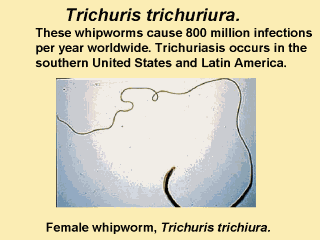| front |1 |2 |3 |4 |5 |6 |7 |8 |9 |10 |11 |12 |13 |14 |15 |16 |17 |18 |19 |review |
 |
Life cycle of Trichuris Trichuriura The unembryonated eggs are passed with the stool. In the soil, the eggs develop into a 2-cell stage, an advanced cleavage stage, and then the eggs embryonate. The eggs become infective in 15-30 days. After ingestion (soil-contaminated hands or food), the eggs hatch in the small intestine and release larvas that mature and establish themselves as adults in the colon. The adult worms (approximately 4 cm in length) live in the cecum and ascending colon. The adult worms are fixed in that location with the anterior portions threaded into the mucosa. The females begin to oviposit 60-70 days after infection. Female worms in the cecum shed between 3,000-20,000 eggs per day. The life span of the adults is about 1 year. Most cases are asymptomatic. Heavy parasite loads cause diarrhea and pain. Diagnosis of stools is often aided by concentration techniques with a centrifuge. |